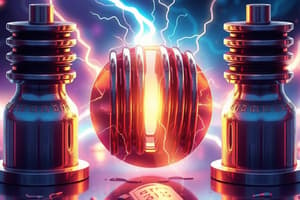Podcast
Questions and Answers
Which metal is the most conductive and commonly used in high-frequency circuits?
Which metal is the most conductive and commonly used in high-frequency circuits?
- Aluminum
- Silver (correct)
- Copper
- Nickel
What property makes aluminum a preferred material for power transmission lines?
What property makes aluminum a preferred material for power transmission lines?
- High ductility
- Lighter weight and cost-effectiveness (correct)
- Resistance to oxidation
- High electrical conductivity
Which alloy is characterized by its low temperature coefficient of resistance?
Which alloy is characterized by its low temperature coefficient of resistance?
- Brass
- Solder
- Nickel-Chromium
- Constantan (correct)
What material is used in heating elements due to its high resistivity and oxidation resistance?
What material is used in heating elements due to its high resistivity and oxidation resistance?
Which category of materials can conduct electricity primarily through the movement of ions?
Which category of materials can conduct electricity primarily through the movement of ions?
What is a primary use of carbon nanotubes in modern applications?
What is a primary use of carbon nanotubes in modern applications?
Which material demonstrates zero electrical resistance below a certain critical temperature?
Which material demonstrates zero electrical resistance below a certain critical temperature?
Which of the following metals is generally used for lamp filaments due to its high melting point?
Which of the following metals is generally used for lamp filaments due to its high melting point?
Which type of conducting material requires doping or exposure to light to conduct electricity?
Which type of conducting material requires doping or exposure to light to conduct electricity?
What is the primary characteristic of graphite as a conducting material?
What is the primary characteristic of graphite as a conducting material?
What do free electrons in metals primarily allow for?
What do free electrons in metals primarily allow for?
How does temperature typically affect the electrical conductivity of metals?
How does temperature typically affect the electrical conductivity of metals?
What is the Fermi level in a metal?
What is the Fermi level in a metal?
What is a significant limitation of the Free Electron Model?
What is a significant limitation of the Free Electron Model?
Which statement regarding electrical resistivity in metals is true?
Which statement regarding electrical resistivity in metals is true?
What characterizes the conduction band in metals according to band theory?
What characterizes the conduction band in metals according to band theory?
What is the impact of impurities on electrical conductivity in metallic alloys?
What is the impact of impurities on electrical conductivity in metallic alloys?
Which statement is true for intrinsic semiconductors regarding temperature and conductivity?
Which statement is true for intrinsic semiconductors regarding temperature and conductivity?
What is the mathematical relationship for electrical conductivity variation with temperature in metals?
What is the mathematical relationship for electrical conductivity variation with temperature in metals?
What is the primary reason n-type semiconductors have higher conductivity than intrinsic semiconductors?
What is the primary reason n-type semiconductors have higher conductivity than intrinsic semiconductors?
What factors influence the conductivity of composite materials?
What factors influence the conductivity of composite materials?
Which material is typically used for lamp filaments due to its high melting point?
Which material is typically used for lamp filaments due to its high melting point?
In the context of fuses, which material is known for its excellent electrical conductivity?
In the context of fuses, which material is known for its excellent electrical conductivity?
What must engineers consider to ensure stable performance of electrical systems over varying temperatures?
What must engineers consider to ensure stable performance of electrical systems over varying temperatures?
Which of the following is a common material used in solder for electronic components?
Which of the following is a common material used in solder for electronic components?
What is a common characteristic of p-type semiconductors?
What is a common characteristic of p-type semiconductors?
Which company operates in various sectors including aviation, healthcare, and renewable energy?
Which company operates in various sectors including aviation, healthcare, and renewable energy?
What environmental consideration is crucial when choosing lead-free solder alloys?
What environmental consideration is crucial when choosing lead-free solder alloys?
What type of conductivity do metal matrix composites exhibit?
What type of conductivity do metal matrix composites exhibit?
Flashcards are hidden until you start studying
Study Notes
Conducting materials
- Conductors allow electric current to flow with minimal resistance.
- Metals are key conductors:
- Copper is widely used due to its high conductivity, good ductility, and corrosion resistance.
- Aluminum is lighter and less expensive, often used for power transmission.
- Silver is the most conductive but expensive, primarily used in high-frequency applications.
- Alloys are metal mixtures enhancing specific properties:
- Constantan (copper-nickel) has low temperature coefficient of resistance, ideal for resistors and strain gauges.
- Nichrome (nickel-chromium) has high resistivity and oxidation resistance, used in heating elements.
- Carbon-based materials are also conductive:
- Graphite offers high conductivity and is used in electrodes, brushes, and as a lubricant.
- Carbon nanotubes have exceptional conductivity and are used in nanotechnology and composite materials.
- Semiconductors conduct under specific conditions, like doping or light exposure.
- Silicon and germanium are key semiconductor materials.
- Superconductors exhibit zero electrical resistance below a critical temperature.
- Examples include niobium-titanium (NbTi) and yttrium-barium-copper oxide (YBCO).
- Used for high efficiency applications like MRI magnets and high-speed data transfer.
- Ionic conductors conduct electricity through ion movement, found in batteries and fuel cells.
Metallic conduction theory
- Free electron theory explains electron behavior in metals.
- Assumptions:
- Electrons in the outer energy levels are weakly bound, becoming free electrons.
- Free electrons move freely within the metal lattice due to minimal potential barriers.
- Thermal motion causes atoms to vibrate, impacting electron movement and creating resistance.
- Important aspects:
- Electrical conductivity is high due to the abundance of free electrons.
- Energy levels and Fermi level: Electrons occupy discrete energy levels, with the Fermi level representing the highest occupied level at absolute zero.
- Band structure: Metals have a partially filled conduction band overlapping with the valence band, allowing easy electron movement.
- Electrical resistivity arises from electron scattering by lattice imperfections and thermal vibrations.
- Limitations of the free electron model:
- Most accurate for simple crystal structures and low temperatures.
- Oversimplifies band structure interactions.
- Doesn't account for anisotropic conductivity or specific behaviors of transition metals and alloys.
Variations of conductivity
- Temperature dependence:
- Metals: Conductivity decreases with increasing temperature due to enhanced lattice vibrations scattering electrons.
- Semiconductors: Conductivity increases with temperature due to electron promotion from the valence to conduction band.
- Composition dependence:
- Metals: Alloy composition affects conductivity, impurities and phase changes can disrupt electron movement decreasing conductivity.
- Semiconductors: Doping with impurities significantly alters conductivity.
- Composite materials: Conductivity depends on the conductivity of both reinforcement and matrix materials.
General Electric
- Multinational conglomerate operating in various segments:
- Aviation: engines, systems, and services
- Power: energy products and services
- Renewable Energy: wind, solar, and grid solutions
- Healthcare: medical imaging and diagnostics
- Capital: financial services
- Founded by Thomas Edison in 1892.
- Global reach with over 205,000 employees.
- Known for innovation and technological advancement, particularly in digital industrial technologies, renewable energy, and healthcare.
- Faced financial challenges in recent years, undergoing restructuring efforts and focusing on core businesses.
- A commitment to environmental and social responsibility, promoting sustainability and renewable energy solutions.
Materials for brushes, lamp filaments, fuses, and solder
- Brushes of electrical machines:
- Carbon brushes are common due to their conductivity, low friction, and wear resistance.
- Graphite is suitable for high-speed applications.
- Metal graphite combines metal particles and graphite providing enhanced conductivity and wear resistance.
- Lamp filaments:
- Tungsten is the primary material due to its high melting point and resistance to deformation at high temperatures.
- Carbon filaments are occasionally used in specialized applications.
- Fuses:
- Copper is widely used for its conductivity and safe current carrying ability.
- Silver is used in high-performance fuses for lower resistance and higher conductivity.
- Aluminum is used in larger fuses for cost-effectiveness and weight reduction.
- Solder:
- Tin-Lead alloy (Sn-Pb) is traditional, offering good flow properties.
- Lead-free alloys like Sn-Ag-Cu and Sn-Cu are used due to lead health and environmental concerns.
- Silver solder contains more silver, providing higher joint strength used in plumbing and electrical connections.
Studying That Suits You
Use AI to generate personalized quizzes and flashcards to suit your learning preferences.




